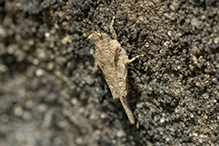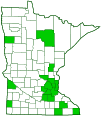obscure pygmy grasshopper
(Tetrix arenosa)
Conservation • Description • Habitat • Ecology • Distribution • Taxonomy
|
|
||||||||||||||
Description |
Pygmy grasshoppers (family Tetrigidae) are recognized by their small size and by the very long pronotum that reaches to the end or well beyond the end of the abdomen. They are among the smallest of all grasshoppers. Obscure pygmy grasshopper is a small, well-camouflaged, pygmy grasshopper. It occurs in the United States and southern Canada east of the Great Plains. It is found in a wide variety of habitats. It prefers moist areas, including streambanks, marsh edges, and temporary woodland ponds. But it is occasionally found in dry areas, including open, deciduous, upland woodlands; sandy pine woodlands; pastures; and cultivated fields. Adults can be found from April through September, but they almost disappear in mid-summer. This suggests that the overwintering adults are active in the spring and the next generation of adults appears in late summer. This is one of the few grasshoppers to survive Minnesota winters as adults. Females are ½″ to 9⁄16″ (13.0 to 13.9 mm) in length. Males are smaller, 7⁄16″ to ½″ (11.0 to 11.7 mm) in length. The body is slender and light brown or gray. The top of the head (vertex), when viewed from above, is broad, nearly twice as wide as one of the eyes, and it projects forward only slightly in front of the eyes. The front margin is slightly convex, almost straight across (truncate), and there is a distinct, raised, longitudinal ridge (carina) in the middle. The carina projects very slightly forward or not at all from the front margin. The plate on the upper face (frontal costa), when viewed from the side, projects well beyond the eyes. When viewed from the front, it is distinctly forked above. The antennae are slender and medium length, longer than the head but not reaching the shoulder region. The plate on the underside on the first thoracic segment (prosternum) extends forward as a semicircular “chin piece” that surrounds the mouthparts like a muffler. The upper plate on the first segment of the thorax (pronotum) is very long and tapered. It is saddle-shaped in front, with side lobes extending down at right angles. The hind margin of each side lobe has twice wavy edges (bisinuate). The pronotum extends well beyond the tip of the abdomen. In front of the shoulder (humeral) area, it is strongly narrowed and distinctly humped. From the humeral area to the tip, it is tapered and nearly flat. It is divided by a slightly raised longitudinal ridge (median carina). The median carina is indistinct for most of its length, but it is slightly raised on the front third of the pronotum. The surface of the pronotum is slightly wrinkled (rugose), and it is covered with small, rounded bumps (granulate). There is sometimes two large, squarish, white spots in the humeral area. When present, there is usually some black on the rear margin. The leathery forewings (tegmina) are rudimentary, reduced to short, elongate-oval pads on the sides of the body. They cover just a small part of the base of the hindwings. The tips are broadly rounded. The hindwings are fully developed and long, extending a little beyond the tip of the pronotum. On the hind legs, the third segment (femur) is greatly enlarged, and the fourth segment (tibia) has numerous spines. On the front and middle legs, the last part of the leg (tarsus), corresponding to the foot, has two segments. On the hind legs, the tarsi have 3 segments, and the first segment is distinctly longer than the third. |
Size |
Female total length: ½″ to 9⁄16″ (13.0 to 13.9 mm) Male total length: 7⁄16″ to ½″ (11.0 to 11.7 mm) |
Similar Species |
Habitat |
Streambanks; marsh edges; temporary woodland ponds; open, deciduous, upland woodlands; sandy pine woodlands; pastures; and cultivated fields. |
Ecology |
Season |
Late April to late June |
Behavior |
|
Life Cycle |
Adults overwinter |
Larva Food |
Same as adults |
Adult Food |
Algae and other organic material in wet soil |
Distribution |
||
|
Sources Hebard, Morgan. (1932). The Orthoptera of Minnesota. University of Minnesota. Minnesota Agricultural Experiment Station. Retrieved from the University of Minnesota Digital Conservancy, https://hdl.handle.net/11299/204015. |
|
| 5/23/2024 | ||
Occurrence |
||
|
||
Taxonomy |
|
Order |
Orthoptera (grasshoppers, crickets, and katydids) |
Suborder |
Caelifera (grasshoppers, locusts, and allies) |
Infraorder |
Acrididea (grasshoppers) |
Superfamily |
Tetrigoidea (pygmy grasshoppers) |
Family |
Tetrigidae (pygmy grasshoppers) |
Subfamily |
Tetriginae |
Tribe |
Tetrigini |
Genus |
Tetrix |
Subordinate Taxa |
|
obscure grouse locust (Tetrix arenosa arenosa) obscure pygmy grasshopper (Tetrix arenosa angusta) |
|
Synonyms |
|
Acrydium arenosum angustum Acrydium arenosum obscurum Tetrix arenosa angusta Tetrix arenosus angustus Tettix angustus Tettix arenosus var. costatus Tettix inflatus Tettix obscurus Tettix gibbosus Tettix fluctuosus Tettix decoratus |
|
Common Names |
|
obscure grouse locust obscure pygmy grasshopper ornate pygmy grasshopper (misapplied) sanded grouse locust |
|
Glossary
Carina
An elevated keel or ridge.
Fastigium
On some insects, especially Orthoptera: the upper part of the forehead, between and often extending in front of the compound eyes.
Femur
On insects and arachnids, the third, largest, most robust segment of the leg, coming immediately before the tibia. On humans, the thigh bone.
Pronotum
The exoskeletal plate on the upper side of the first segment of the thorax of an insect.
Tarsus
On insects, the last two to five subdivisions of the leg, attached to the tibia; the foot. On spiders, the last segment of the leg. Plural: tarsi.
Tegmen
The modified, leathery front wing of grasshoppers and related insects that protects the hindwing. It may also serve as a camouflage, a defensive display, or a sound board. Plural: tegmina.
Tibia
The fourth segment of an insect leg, after the femur and before the tarsus (foot). The fifth segment of a spider leg or palp. Plural: tibiae.
Vertex
The upper surface of an insect’s head.
Visitor Photos |
||
Share your photo of this insect. |
||
This button not working for you? |
||
Greg Watson |
||
 |
||
MinnesotaSeasons.com Photos |
||
|
||
|
||

Slideshows |
|

Visitor Videos |
||
Share your video of this insect. |
||
This button not working for you? |
||
|
Other Videos |
||
|

|
Created: 5/24/2024 Last Updated: © MinnesotaSeasons.com. All rights reserved. |


